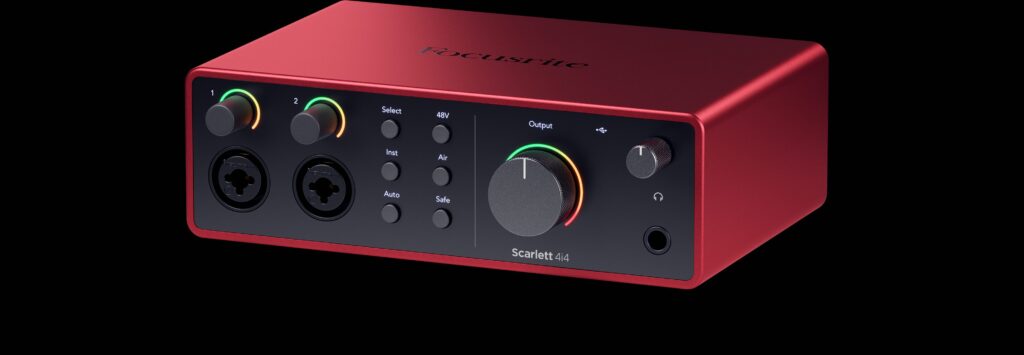Focusrite introduces the Scarlett 4i4 4th Gen audio interface, which packs useful pro features, reliable functionality, upgrades, and more.
By Lexi Ferguson
The Scarlett 4i4 4th Gen audio interface from Focusrite packs useful pro features, reliable core functionality, and handy upgrades in a compact form factor and at a competitive price. The 4i4 is the top of the range of the most recent Scarlett 4th Gen offerings, with larger interfaces still available in their Focusrite’s 3rd Gen Scarlett line. The 4i4 4th Gen will accommodate the needs of most DJ streamers, home-studio producers, independent podcasters, or solo live performers.
Start Up: I had no trouble setting up the Scarlett 4i4 4th Gen for the first time. The interface started working on my Macbook Pro M1 right away without installing any driver or application. The 4i4 is meant to be used in conjunction with the included Focusrite Control 2 software, which unlocks the full feature set.
The 4i4 4th Gen works flawlessly via bus power with computers that supply enough juice over USB. My Macbook Pro M1 had no trouble powering the Scarlett on its own, though the same might not be true for older Intel Macbooks. While I did most of my testing on a Macbook Pro M1, I also own a PC laptop and did brief testing with that computer as well. I had a similarly smooth overall experience, although my 2021 model Intel PC laptop could not supply enough bus power for the Scarlett 4i4 4th Gen to work without the included AC power adapter. The front panel of the Scarlett unit gives you immediate feedback whether or not it’s getting enough power via a green- or red-lighted charge symbol.
Build: I generally had a high degree of confidence in the stability and reliability of the 4i4 4th Gen, supported by its appearance and apparent build quality. The chassis is made of metal, while the front and back panels are made from sleek black plastic. It feels both lightweight and sturdy.
Use: Using the interface for production, music preparation, and home entertainment went perfectly smoothly. In the past, I’ve experienced some instability with previous generations of the Scarlett line. My production students who use Windows sometimes experienced significant trouble using Zoom without crackling audio.
I’ve used older Scarlett units while recording musicians in Panama, and also while running the production booth over the years at the official Burning Man radio station. In my personal experience with those units, I sometimes had issues when the USB cable shifted or was bumped, which would disconnect the unit in the middle of using it. With the 4i4 4th Gen, I didn’t have any of these issues, even while intentionally jiggling the cable connection.
Output: The Scarlett 4i4 4th Gen has four physical output channels, which will most commonly be used as two stereo pairs, plus a fifth headphone output channel. Outputs 1 and 2 are controlled by the large Output knob on the front panel. As is common with other interfaces, Outputs 3 and 4 are not controlled by any physical volume knob, and will come through your speakers at maximum volume. You can lower the volume within the Focusrite Control 2 software.
It also has an additional stereo audio channel for its Loopback feature, which lets you natively record your computer’s overall system output – including web browsers and audio players – without the need for additional software like Blackhole, VoiceMeeter, or Rogue Amoeba’s separate Loopback software. The Scarlett’s native Loopback feature is available on all interface units of the Scarlett 4th Gen line, although the 4i4 has more flexibility in routing the audio than its smaller siblings. On the 4i4 4th Gen, the Loopback audio shows up as Inputs 5 and 6. You can then use this special input for OBS streaming, Zoom meetings, or simply recording browser audio into your DAW.
Inputs: The Scarlett 4i4 4th Gen has four physical audio inputs: two combo XLR-¼-inch inputs on the front panel, and two ¼-inch inputs on the back panel. It has four outputs on the back panel, all ¼-inch jacks.
The 4i4 has four knobs on the front panel – two input gain knobs to control each of the combo XLR-¼-inch audio inputs, an output knob for the speaker output volume, and a headphone output volume knob. The input gain knobs on the 4th Gen model use an infinite encoder, while the output knobs are mechanical and have a fixed low and high boundary past which you can no longer physically turn it.
The input gain knobs are physically different from the output volume knobs, with a rubbery outer texture. The other two knobs are made of metal, with scored sides, presumably to improve grip. Ironically, I found the rubber knobs to have much better grip than the metal knobs, despite the texture given to the metal knobs. It’s a notable difference. I couldn’t use the light touch to I’m accustomed to and prefer to use with my gear, including my Apollo interface and the DJ mixers and controllers I use most often. Of course, the metal knobs turn easily with a tighter grasp; however, I’m forced to wonder why they’d use any knob that slips through the fingers so easily, especially when their rubber knobs work so well.

Other Features: The ring of light around the input gain knobs shows two kinds of information. While you’re turning the knob, it shows the amount of gain applied; and once you’ve set the level, the ring of light switches to show you the live level of the input signal.
The front panel has six buttons for additional options to control the input signals. The Select button switches focus between Input 1 or Input 2, and the other 5 buttons apply their functions to whichever input is currently selected.
The button marked 48V applies phantom power to the selected XLR input to power condenser microphones. The Inst button refers to “Instrument Level” and applies extra gain for instruments that need additional amplification. Press it a second time to return to neutral Line Level.
The Air button has two modes. Press once for green, which adds “Air Presence” – typically a phrase like that means a high-frequency EQ boost, and that’s what it sounds like here; then press the Air button twice for Air Presence in combination with “Harmonic Drive,” which refers to subtle saturation. In production settings, I prefer to add these effects myself, so I can dial in exactly what I want, and change it after the fact. In a live setting like a livestream or radio show, I could see these modes being a very useful shortcut to a great sounding vocal on the fly. I personally found both Air modes to offer subtle improvements to my speaking voice, and I think it’s quite useful.
The Auto button activates auto gain, a mode which listens to the signal for 10 seconds and decides on the optimal gain level. When I tested the Auto button, it worked quite well. It only judges based on 10 seconds and does not update continuously, so it would be best to set it with the loudest part of your performance.
The Safe button listens for when your input signal is clipping and reduces the input gain to preserve a clean signal. When I tested the Safe button, it worked as advertised, pulling back the volume in small increments as I got louder. It seems to reduce the input gain in 4db chunks as necessary. The Safe mode only reduces volume, so watch out – if you have a brief loud moment in your input audio, the rest of the performance will be reduced in volume, compared to before the volume spike.
Conclusions: If you want to stick with the Scarlett range and need more inputs and outputs or more than one headphone output, then you’ll have to get the 8i6 3rd Gen, which sacrifices the new 4th Gen functions of Auto and Safe, the new input gain light behavior, and notably increased input gain range. The next step down from the 4i4 ($279.99 MSRP) is the 2i2 4th Gen ($199.99 MSRP), which cuts the number of inputs and outputs in half, though it retains most of the features of the 4i4 including the great 4th Gen preamp and their input gain range.
Otherwise, The Scarlett 4i4 4th Gen is a fantastic audio interface. It has everything you need for the most common uses at a competitive and reasonable price.


